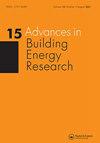Developing a model for predicting optimum daily tilt angle of a PV solar system at different geometric, physical and dynamic parameters
IF 2.5
Q2 CONSTRUCTION & BUILDING TECHNOLOGY
引用次数: 12
Abstract
ABSTRACT Capturing the solar radiation that passed through the Earth’s atmosphere and received by solar panels depends on several parameters. In this paper, all governing parameters of the total daily solar radiation are provided in mathematical relations. In the first stage, the mathematical model is converted to a computer-based model by using the MathCAD program. In the second stage, however, the control variables, tilt angles, surface azimuth angles, day of year, and ground reflectance are identified. Based on the total daily solar radiation objective function, three scenarios are proposed in this study for different situations of variation of control variables. In the final stage the optimization flowchart is designed for the optimum daily tilt angle. The model’s innovation to simultaneously analyze the mean effects of control variables on the dynamic and optimum tilt angles simulation was designed based on 3 scenarios for a PV solar system of the building in Montreal in different seasons. After analyzing the correlation among the scenarios, values of the average optimum tilt angles for each scenario are simulated in angle ranges of 60° to 65° for the winter, 20° to 22.5° for the spring, 27.5° to 35° for the summer, and 68° to 75° for fall.建立了在不同几何、物理和动态参数下预测光伏太阳能系统最佳日倾角的模型
摘要捕获穿过地球大气层并由太阳能电池板接收的太阳辐射取决于几个参数。本文以数学关系式给出了日总太阳辐射的所有控制参数。在第一阶段,通过使用MathCAD程序将数学模型转换为基于计算机的模型。然而,在第二阶段中,确定了控制变量、倾角、地表方位角、一年中的哪一天和地面反射率。基于日总太阳辐射目标函数,本研究针对不同情况下控制变量的变化提出了三种情景。在最后阶段,针对最佳的每日倾斜角度设计优化流程图。该模型的创新之处在于同时分析控制变量对动态和最佳倾角模拟的平均影响,该模型是基于蒙特利尔建筑光伏太阳能系统在不同季节的3个场景设计的。在分析了场景之间的相关性后,在冬季60°至65°、春季20°至22.5°、夏季27.5°至35°和秋季68°至75°的角度范围内模拟了每个场景的平均最佳倾角值。
本文章由计算机程序翻译,如有差异,请以英文原文为准。
求助全文
约1分钟内获得全文
求助全文
来源期刊

Advances in Building Energy Research
CONSTRUCTION & BUILDING TECHNOLOGY-
CiteScore
4.80
自引率
5.00%
发文量
11
 求助内容:
求助内容: 应助结果提醒方式:
应助结果提醒方式:


